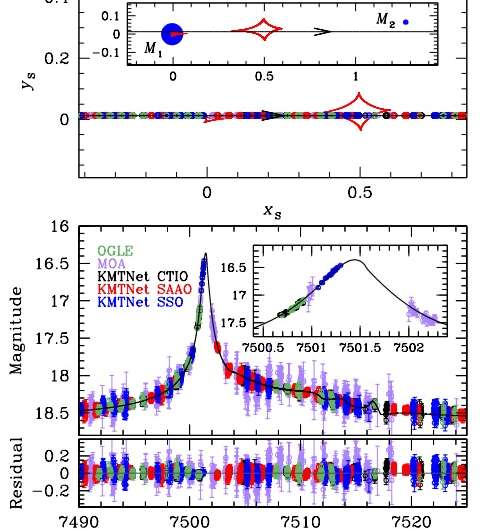November 9, 2016 report
Impostor planet exposed by astronomers

(Phys.org)—Don't be fooled by its light curve exhibiting anomalies like those caused by planets—one microlensing event with a fancy name OGLE-2016-BLG-0733 is doing a really good job of mimicking an extrasolar world. This case of a binary-source event masquerading as a planet could have further implications for the search of exoplanets using the gravitational microlensing method.
In contrast to other methods, microlensing is most sensitive for detecting planets around one to 10 AU away from their host stars. This method is also used to find new exoworlds around faint and dark objects at or beyond the snow line, and those not gravitationally bound to their parent stars. However, the correct interpretation of the signal provided by the microlensing method is often difficult due to various scenarios that can mimic planetary signals.
This is the case with OGLE-2016-BLG-0733—a microlensing event discovered in April 2016 by the Early Warning System (EWS) of the Optical Gravitational Lensing Experiment (OGLE) survey, which is conducted using the 1.3m Warsaw telescope located at Las Campanas Observatory in Chile. According to a paper published Nov. 2 on arXiv.org by an international team of astronomers, this event is the first example of a new class of planet impersonators. The team was led by Youn Kil Jung of the Harvard-Smithsonian Center for Astrophysics in Cambridge, Massachusetts.
David Bennett of NASA's Goddard Space Flight Center in Greenbelt, Maryland, told Phys.org, "We know that OGLE-2016-BLG-0733 has a binary source with no evidence of a planet orbiting the lens star, although it could have a planet outside the region of microlensing sensitivity. It is doing a very good job of mimicking the planet."
At first, the team expected to detect the presence of a planet. However, the planetary model exhibited "suspicious" behavior, having very unlikely parameters, which led them to investigate other possible scenarios. More importantly, the data acquired by the scientists very clearly favored the binary source model.
The new study shows that binary sources with roughly equal-luminosity components like OGLE-2016-BLG-0733 can mimic long-term perturbations induced by planets with projected separations near the so-called Einstein ring (deformation of the light from a source into a ring through gravitational lensing). The results indicate that OGLE-2016-BLG-0733 indeed induces broad perturbations to the light curve, which are then confused with a broadened central peak and large planetary deviation—characteristic for a planet near the Einstein ring.
The research could have implications for future exoplanet hunting, as binary source events can occasionally mimic planetary microlensing events.
"This issue was first discussed 18 years ago, but for most planetary events it is not an issue because the light curves have features that are really unique to microlensing. Some of the earliest planetary microlensing papers worried about this issue, but these binary source events are rare enough that this possibility could be forgotten," Bennett noted.
The team concluded that when future high-cadence, round-the-clock surveys will be capable of detecting much subtler planetary signals, it could be even more challenging to distinguish whether a signal is caused by a planet or just a source mimicking it.
"The problem of distinguishing such planetary light curves from other physical effects will be much more challenging than in the past, but extremely important for interpreting statistical results about planet populations," the paper reads.
More information: Binary Source Event Masquerading as Planet: A New Manifestation of the Binary-Source Degeneracy, arXiv:1611.00775 [astro-ph.SR] arxiv.org/abs/1611.00775
Abstract
We present the analysis of the microlensing event OGLE-2016-BLG-0733, which introduces a new type of degeneracy between binary source and planetary perturbations. The light curve of the event exhibits a long-term asymmetric perturbation that would appear to be due to a planet. From detailed analysis of the light curve, however, we find that the perturbation originates from the binarity of the source rather than the lens. This result demonstrates that binary sources with roughly equal-luminosity components can mimic long-term perturbations induced by planets with projected separations near the Einstein ring. The result also signifies the importance of considering various interpretations of planet-like perturbations and of high-cadence observation not only for resolving the degeneracy but also for ensuring the unambiguous detection of the planet.
© 2016 Phys.org




















